| May
21, 2006
Hello from Ottawa – The Canadian Tulip
Festival Features the Flotilla: Parading Boats on Dows Lake
For a period of almost three weeks, the Canadian
Tulip Festival offers a wide range of special events and festivities,
and the Flotilla on the Rideau Canal is certainly one of the highlights.
This morning I made my way down to Dow’s Lake through the
leafy historic neighbourhoods of Ottawa. I parked my car about 20
minutes away from Commissioner’s Park which gave me the opportunity
of a nice morning stroll through some of the gorgeous residential
areas in Ottawa. Queen Elizabeth Driveway had been blocked off to
road traffic, but yesterday I had the opportunity to drive right
next to the Rideau Canal - it simply has to be one of the most scenic
areas in Ottawa and one of the most serene public spaces in any
of the big world cities that I have visited.
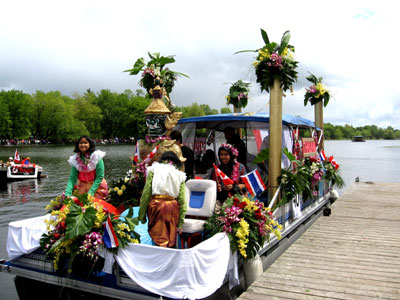
People were lining up beside Dow’s Lake and no one was quite
sure if the weather was going to hold up or not, so there were many
umbrellas to be seen in the crowd. But that didn’t deter a
large number of loyal onlookers from gathering on the shores of
Ottawa’s urban lake, ready to take in the beautiful images
of the Flotilla. Ottawa’s parade on the water is one of the
highlights of the Tulip Festival and this year more than 40 especially
decorated boats participated.
The Flotilla Weekend features a variety of events, including Music
on the Lake on a floating stage; there is a remote-control model
boat exhibition and historic blacksmithing demonstration. The main
event, the Flotilla started at 1:00 pm at Dows Lake and decorated
boats of varying types and sizes paraded along the Rideau Canal
all the way up to the Rideau Street Bridge. Along the route there
is entertainment, refreshments and bilingual commentary introducing
the participants.
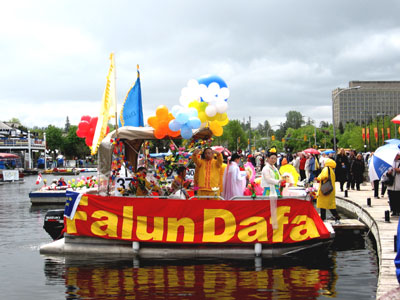
Always curious, I made my way towards the announcer right next
to the Dows Lake Pavilion who was dispatching and describing each
floating participant in the parade. Right next to the announcer
I found one of the key people behind the
Canadian Tulip Festival: Benoît Hubert, the Executive
Director of this non-profit organization who sat down with me to
give me a better background of Ottawa’s largest festival.
The Canadian Tulip Festival got its start in 1953 and has very
interesting historical roots: Queen Juliana of the Netherlands (1909
– 2004) went into exile to Canada during the Second World
War and her daughter, Princess Margriet, was born at the Ottawa
Civic Hospital. Canadian soldiers also played an integral role in
liberating the Netherlands from Nazi occupation at the end of World
War II. As a gesture of appreciation Princess Juliana sent 100,000
tulips to Canada in the fall of 1945 and this tradition has continued
every year since then with an annual shipment of tulips from Holland.
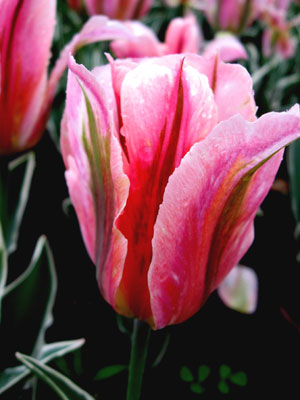
The Tulip Festival has become a symbol of international friendship
and over the last 53 years has evolved into the World’s biggest
tulip festival. World-wide interest in this festival was stoked
early when internationally renowned photographer Malak Karsh presented
his stunning tulip pictures which appeared in newspapers all across
the nation. Today more than two million flowers grace Ottawa during
the festival, and the National
Capital Commission, a federal agency with a mandate to beautify
the National Capital Region, is in charge of the hundreds of flower
beds and gardens that adorn the city.
Benoît mentioned that this year is a very special year since
Ottawa is hosting the World
Flower Council, an organization that promotes peace through
the shared joy of flowers. The conference is introducing an international
flavour to this year’s Tulip Festival and even the Flotilla
had participants from the Netherlands, Thailand, Turkey, Taiwan,
and France. He went on to explain that during the Kid’s World
events, more than 3000 children come every day from different schools
to learn about the history of the tulip.
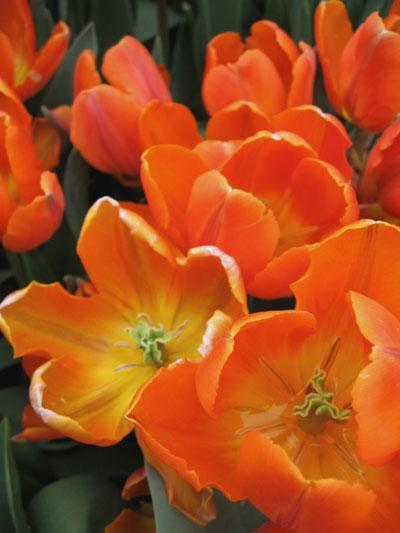
The historical background of the tulip is surprisingly interesting:
as a flower it is native to southern Europe, northern Africa and
Asia, all the way from Anatolia and Iran east to northeast China
and Japan. The tulip is the national flower of Iran and Turkey,
and Persian and Turkish folk art prominently feature tulip motifs.
Over the centuries tulips became more popular and moved westwards
where Holland became the world’s primary tulip producer.
During the 1600s Holland was gripped by a regular “tulip
mania” which makes the stock market crash of 1929 pale in
terms of its speculatory excesses. At the peak of this crazy historic
period, enormous prices were charged for a single tulip bulb. Today
the term “tulip mania” has come to mean any large economic
bubble. The historic appeal of the tulip has continued, evidenced
by the fact that the Tulip
Festival is Ottawa’s biggest festival, and incidentally
the largest festival of its kind in the world. It attracts somewhere
between 600,000 and 650,000 visitors in 19 days and generates C$
70 million in revenue for the National Capital Region.
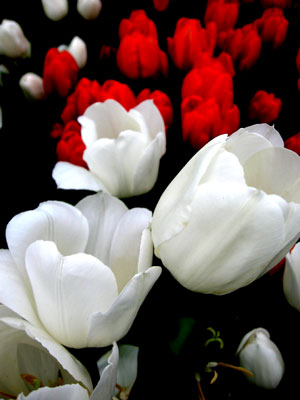
It is interesting to note that the Canadian Tulip Festival is a
non-profit organization that only has three full-time employees
year round. Leading up to the festival staff levels grow to 45 full-time
employees and more than 1200 volunteers who play an integral part
of this special event. The Canadian Tulip Festival enjoys the generous
support of major sponsors such as the Casino du Lac-Leamy and the
Hilton Lac Leamy, CTV, the Ottawa Citizen and Sun Life Financial.
Government Partners include the City of Ottawa, the Federal Government
(Human Resources Development, Canada Economic Development for Quebec
Regions and Heritage Canada), Ontario’s tourism marketing
agency ("Ontario - More To Discover"), the National Capital
Commission (who is the “official gardener “of Canada’s
Capital) as well as the City of Gatineau. From corporate sponsors,
to public sector partners to private individuals, the Canadian Tulip
Festival is a magnificent collaborative effort that mobilizes the
entire National Capital Region on the Ontario and Quebec side and
attracts visitors from all over the world.
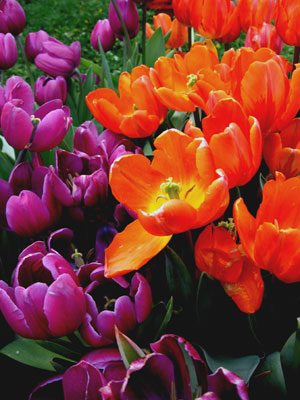
The Tulip Festival has four official sites, all lavishly decked
out with flower beds featuring different varieties of the coveted
tulip. Parliament Hill, Majors
Hill Park, Commissioners Park next to Dow’s Lake and the
Casino du Lac-Leamy are
all official Tulip Festival sites and host a variety of events,
concerts and displays during an almost three week period.
The Capital Infocentre on Parliament Hill provides all the necessary
information for visitors of the Tulip Festival and the Parliament
Buildings are adorned by thousands of these iconic spring flowers.
Commissioner’s Park showcases more than 350,000 tulips planted
by the National Capital Commission. The Casino du Lac-Leamy in Gatineau
on the other side of the Ottawa River has been hosting the “Tulip
Explosion” for the last three years. This event encompasses
floral shows, dress and hair design competitions as well as floral
design competitions. Seven different schools compete for the top
prize in floral design. Major’s Hill Park plays host to the
Tulip Friendship Village, the Artisans Marketplace, to the Family
Zone entertainment area as well as the Get Out! Ottawa Citizen Concert
Series.
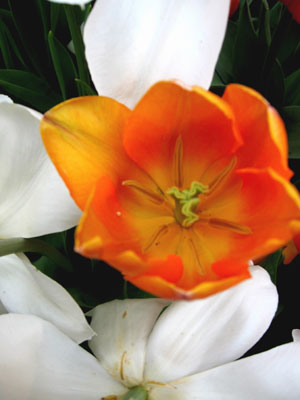
Benoît also informed me of the 16 attraction sites that are
part of the Tulip Festival: all of Ottawa’s and Hull / Gatineau’s
major attractions are part of this spring festival. Some of the
attractions on this long list include the Canadian
Agriculture Museum, the Dows Lake Pavilion, the Canadian
Museum of Nature, the Canadian
Museum of Contemporary Photography, the Rideau Centre, the National
Gallery of Canada, the Royal Canadian Mint, the
Canadian War Museum, Little Italy and many more.
There is no doubt that the Canadian Tulip Festival with all its
attractions, special events, concerts and displays is a major tourist
draw. Even the couple from Rochester that I met at the
Auberge McGee said that the Tulip Festival was the main draw
for them to come to Ottawa and it’s a wonderful way to get
to know the City of Ottawa and its neighbour Gatineau across the
River. It’s a great opportunity to celebrate the arrival of
spring and the international friendships that are symbolized by
the Canadian Tulip Festival.
Related Articles:
Hello from Ottawa
- Overview of my first excursion to Ottawa's Tulip Festival
Hello from Ottawa - Arrival,
two photo exhibitions and my own photo safari
Hello from Ottawa - Doubling up
on antiquity at the Canadian Museum of Civlization
Hello from Ottawa - Sweetgrass Bistro:
Aboriginal dining in the ByWard Market
Hello from Ottawa - The historic
McGee's Inn: 2 couples embark on the adventure of joint B&B
ownership
Hello from Ottawa - The Canadian
Museum of Nature and Fatal Attraction: seduction in the
animal world
Hello from Ottawa - Gatineau Park,
Ottawa's nature playground
Hello from Ottawa - Major's Hill
and a live TV interview
Hello from Ottawa - Bistro 115: Authentic
French-Canadian cuisine in the ByWard Market
Hello from Ottawa - Historic transportation
on the Hull-Chelsea-Wakefield Steam Train
Hello from Ottawa - The Wakefield
Mill Inn & Spa: from historic gristmill to upscale lodging,
dining and pampering
Hello from Ottawa - Flower
and dress design at the Casino du Lac-Leamy
Hello from Ottawa - The Flotilla
- a parade of decorated boats - and an interview about the background
of the Tulip Festival
Hello from Ottawa - Sheep shearing
at the Canadian Agriculture Museum
Hello from Ottawa - Tractors,
cows and small animals at the Canadian Agriculture Museum
Hello from Ottawa - My 2-day
packed itinerary for Winterlude
Hello from Ottawa - First
impressions and an overview
Hello from Ottawa - The Lord Elgin
Hotel: a historic landmark in the heart of Ottawa
Hello from Ottawa - Fat Tuesday's
and the Mardi Gras Experience in the ByWard Market
Hello from Ottawa - An early
morning walk to Parliament Hill
Hello from Ottawa - Skating
on the Rideau Canal, the World's Largest Skating Rink
Hello from Ottawa - Charity and
hilarity: the 26th Annual Bedzz Races on Dow's Lake
Hello from Ottawa - Confederation
Park and other Winterlude locations
Hello from Ottawa - Darcy McGee's:
a historic Irish pub on Sparks Street
Hello from Ottawa - The Canadian
War Museum and "Weapons of Mass Dissemination - The Propaganda
of War"
Hello from Ottawa - The
Canadian Museum of Contemporary Photography featuring Sunil Gupta
and the challenges of immigration
An interview with Tourism Ottawa
provides a great overview of this city
An interview about
the ByWard Market, a prime entertainment and shopping area
An interview
with the National Gallery of Canada
An interview
with the Canadian Museum of Civilization
Helpful websites:
Ottawa
Tourism: Ottawa's official tourism information
The ByWard
Market Business Improvement Area
The
National Capital Commission
The National
Museum of Civilization
The National Gallery
of Canada
The Canadian War
Museum
The Canadian Museum
of Nature
The
Canadian Agriculture Museum
Useful books about Ottawa:
|